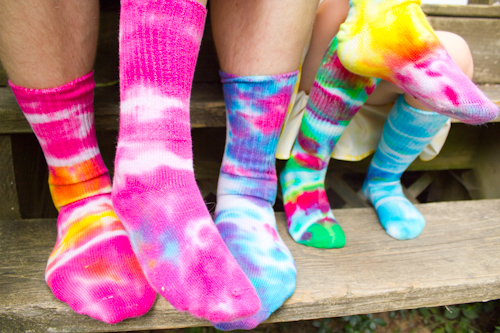
How to tie dye to refresh dingy or stained clothes.
Summer is the best time to tie-dye. Even with gloves on, tie-dye is a messy project, with a couple of iffy chemicals that you don’t necessarily want in your kitchen, but outside you can spread out and make your mess in the fresh summer air, and if you sit on the grass then you won’t even have the driveway to hose off when you’re done.
Additionally, tie-dye works best when it’s allowed to set for 24 hours in an airtight container, and the steamier and the muggier the environment that it sets in, the better. Know any place steamier and muggier than your backyard in the summer?
I love to tie-dye our stained and/or dingy clothes to upcycle them back into nice clothes, and I love to tie-dye with my messy, creative kids. It’s a fun, accessible project with great results. Check out how to do your own tie-dye below:
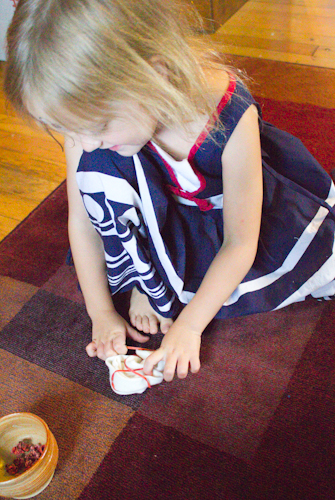
You can tie-dye any fabric made from plant-based fibers– anything cotton, anything linen, anything jersey knit, etc. Protein-based fabrics, such as silk and wool, require different dyes (have you ever dyed silk with Kool-aid?), but if you’ve got anything from T-shirts to tablecloths, then you’re ready to tie-dye.
To tie-dye a fabric, you first must tie off portions of it, either by wrapping the fabric with rubber bands, or simply tying it into knots. You can do this at random, like the five-year-old here (her tie-dyed socks turned out AWESOME, by the way), or you can search online for specific tie-dye techniques.
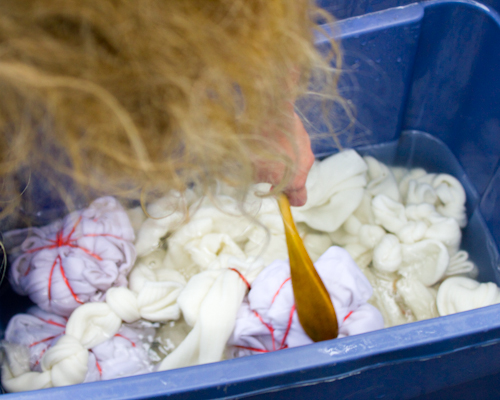
Purchase the best-quality tie-dye dye that you can easily afford. That being said, I go to garage sales pretty regularly in the summer, and I’m perennially finding brand-new really nice tie-dye kits for just a buck or two, so if you’re in the market for dye, then a quick query through craigslist or freecycle never hurts. The re-use gets you your eco-friendly props, too, as if you need more of those.
Unless you’re using dye that doesn’t require it, your next step is to soak your fabric in a big bucket of soda ash and water. You want to follow the manufacturer’s recommended ratio for this. Soda ash is the only kid-unfriendly ingredient in this process, so I keep it out of my kitchen altogether by mixing it up outside, using the garden hose for water and a kid with a long-handled spoon for stirring.
This soda ash solution can be re-used, so if you have the means to store it, then you can use it if you plan to tie-dye again in the near future.
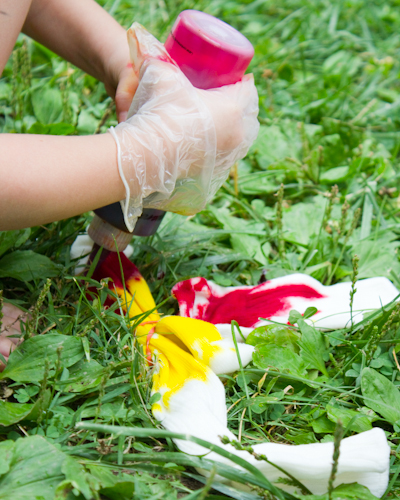
After you’ve soaked your fabric for the recommended time, pick it up, wring it out, and you’re ready to dye.
For the best application, put your mixed dyes into old mustard bottles so you can squirt the dye exactly where you want it on the fabric. You can use the pointy nozzle of the bottle to poke into the folds of the fabric, and you can get quite detailed with color and design.
NOTE: Boy, will this dye stain your skin! I actually don’t really care that much, myself, but if you do, all you need are a pair of gloves and you’re all set.
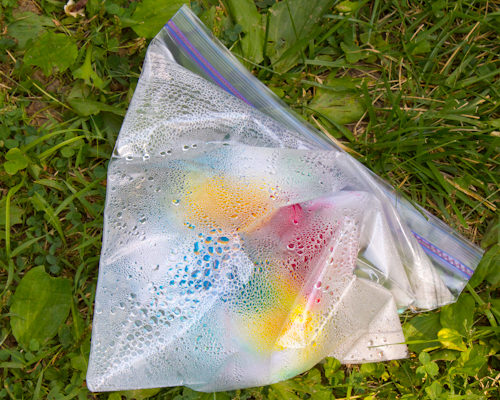
For best results, your dye will need to set for about 24 hours, and it will need to stay wet for that entire time. To accomplish that, plop your dyed article into an old plastic zip-top bag or grocery store bag (another excuse to call upon freecycle!) and tie the plastic bag off. Simply leave the closed bag out in the yard, and when you come back in 24 hours, I guarantee that your article will be all wet and warm and steamy inside its bag and that’s exactly what you want.
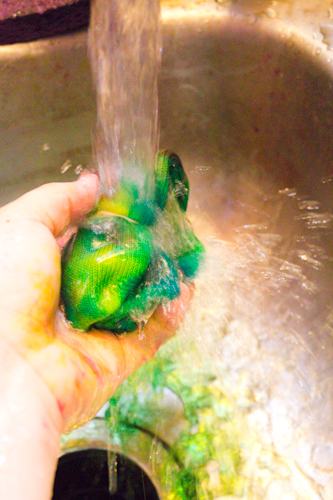
Some crafters simply throw their dyed article into their washing machine for its rinse, but I have an he washing machine, which doesn’t use water the same way that a conventional washing machine does, and so I usually choose to hand-rinse my dyed items under the kitchen faucet. You want to rinse your item until the water runs clear, and then take off the rubber bands or untie the fabric so that you can admire what you’ve got.
If you often dye fabric, then you might want to splurge on a professional textile detergent, but otherwise all you have to do to finish is to wash your tie-dyed article in your washing machine with your regular detergent and in hot water. I like to throw in some extra vinegar as a rinse aid, but it’s strictly optional
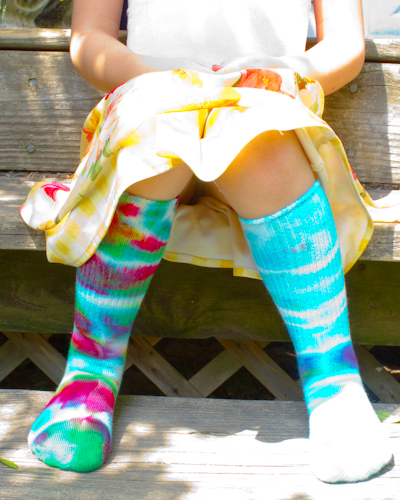
Now all you have to do is restrain yourself from walking around town in a completely tie-dyed wardrobe, because yes, it really IS that fun.

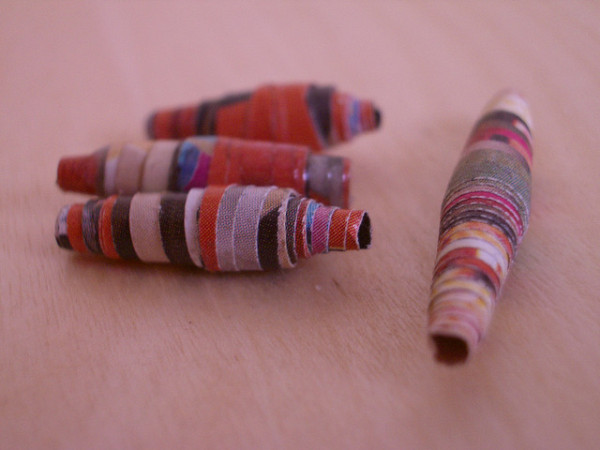
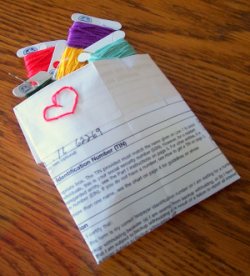


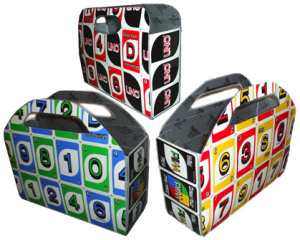
Tie-dying is cool and all, but I’m not really sure it belongs on this blog. I would worry about the chemicals your washing down the drain when you rinse excess dye out of the fabric. Have you ever experimented with using natural dyes for tie-dying. Or possibly another kid-friendly, fun clothing alteration project that doesn’t require high quality chemical dyes?
Thanks
There are lots of ways to be eco-friendly. There is room for different methods, and each method doesn’t have to be perfection. This particular method focuses on upcycling stained or dingy clothes, not on chemical-free crafting. Natural dyes are also eco-friendly, but they’re not the only correct way to be eco-friendly.
I agree with Esther – I’m never sure exactly whether those tie-dye kits are all that eco-friendly.
This is such a great idea! I knew that tie-dye existed, of course, but I never thought about using it on clothing that’s not new. I have so many Gerber baby onesies in all sizes that just don’t look nice enough anymore to pass down to my next baby, but I’m thinking now that I can tie-dye them for much cheaper than I can buy all new ones, and they’ll look even better! Thanks!
Do these dyes work out in the sun like SetAColor?
No, leaving the dyed fabric out in the sun in a watertight container (like an old grocery bag) is only to allow the fabric to remain damp and warm, preferably steamy, for longer. The dyes are not heliographic, and actually, if you didn’t want to leave them outside like I do, you could certainly experiment–perhaps tie them up an an old grocery bag and put them in your dryer for an hour? Skip that step altogether and see if the colors are nevertheless saturated enough to suit you?
Pingback: 101 MORE Ways to Embrace Summer | Family Your Way
Pingback: Pirates, Princesses, and Mouse Ears: Upcycled Disney Crafts | Crafting a Green World
Pingback: Muse of the Morning • Round-Up: It’s Totally Sock Weather!
Definitely will be doing this. Thanks
Does anybody have eco-friendly alternatives to using plastic bags? I know this article said to upcycle grocery/zip lock bags, but for anyone have other ideas? Thanks!